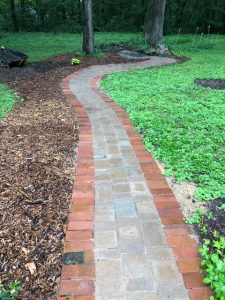One Brick at a Time: Another Productive Chat With Neo

The imaginary talking neocortex of my brain, whom I call Neo, looks up from reading my column, “Possibilities with Parkinson’s.”
“Hey, Doc. I still don’t understand this conductor theory. How can I use it as a treatment for my Parkinson’s?” he asks, referring to a mental construct Dr. C has developed to shift his perspective while managing Parkinson’s.
“Hold on a minute, my friend.” Dr. C responds. “The conductor/exercise training I’ve frequently written about is not a treatment yet. It’s just one man’s idea about an intervention that might help. More research needs to be done. I wouldn’t even know how to scale it up to the larger population based only on my own experience.”
“I think it’s a cool idea, you know,” Neo says. “Training my own brain to make dopamine.”
Dr. C settles into his chair.
“I may seem to suggest that, but what I really think is that we can slow the progression of Parkinson’s and the severity of its symptoms by using conductor/exercise training,” Dr. C says. “If such a thing is possible, then it will be up to the medical research scientists to provide explanations.
“One of my important goals is to leave this world better than it was when I arrived,” he adds. “Achieving this requires a long-term functioning conductor, and it plays an important role in goal-driven behavior.
“Any conductor/exercise training would need to be individually tailored to be of most benefit to an individual to meet their goals.
“Offering myself as a case study is risky on many levels, but it’s just one piece of the whole picture. Information about a second dopamine center is growing, along with its impact on nonmotor Parkinson’s symptoms — many of which match my own.
“The scientific literature suggests that this second dopamine area is connected to the default mode network, our resting mind state. This means we have a built-in mechanism for moderating the input coming from the second dopamine center. This is exemplified in my “Fresh Look” columns about Parkinson’s and pain, and Parkinson’s-related depression. My question is: If we engage this buffering mechanism, does it activate the dopamine neurons?
“I believe it does. And I believe the result is an improvement, or slower decrease, of some of the physical symptoms, as in my case.
“If you then add physical exercise, the positive effects of both the conductor and exercise are enhanced.
“But I want to repeat: This is not a treatment. I am offering it as a case study of someone who might be an example of Parkinson’s damage in the second dopamine center more than the more widely understood nigrostriatal area.”
Neo looks a little confused. “OK. So, if it isn’t a treatment, then what should I do with all of this information?”
“The early steps in using the conductor focus on developing and maintaining a pause between emotional or exaggerated sensory input, a pause before thought or action,” Dr. C replies.
“The pause allows the conductor to be utilized. The idea is based on neural plasticity: If I stimulate the right pathways, then I can build a bridge around the damaged brain areas. The bridge I build in my brain won’t look the same as the one someone else would build. It takes years of hard work to rewire the brain.
“We have this saying at our house: ‘one brick at a time.’ Keep at it every day, even if it’s just one small thing a day, just one brick a day, and eventually it will turn into a path.”
Mrs. Dr. C chimes in: “I think I can give some testimony to Dr. C’s efforts in training the conductor. I see fewer uncontrolled outbursts, and I see him taking stock of his emotions before he says or does something he might regret.”
Neo laughs. “Dr. C has outbursts? I can’t picture that!”
“Oh yes,” Mrs. Dr. C says, smiling. “It used to be that the slightest provocation would trigger them. Now, we anticipate that he might have difficulty using the conductor in highly stressful situations. In general, day-to-day responses are well managed. But it took him several years to do that.”
“Of course,” she adds wistfully, “we try to anticipate when a highly stressful situation might rear its ugly head. We try to space out appointments and commitments with enough time in between to rest. I give him an update several times during the week about what is coming up on the calendar. I guess you might say that I am helping his brain conductor know when the ‘trains’ are coming down the track.”
“Perhaps I need a Mrs. Dr. C to help me work on my brain conductor training,” Neo says. “Maybe other Parkinson’s caregivers or family members should understand what this means so they can help their Parkinson’s partner.”
Dr. C smiles at Mrs. Dr. C. “I can’t imagine what I would do without her helping me lay one brick at a time.”
***
Note: Parkinson’s News Today is strictly a news and information website about the disease. It does not provide medical advice, diagnosis or treatment. This content is not intended to be a substitute for professional medical advice, diagnosis, or treatment. Always seek the advice of your physician or another qualified health provider with any questions you may have regarding a medical condition. Never disregard professional medical advice or delay in seeking it because of something you have read on this website. The opinions expressed in this column are not those of Parkinson’s News Today or its parent company, Bionews, and are intended to spark discussion about issues pertaining to Parkinson’s disease.








Derek Marshall
The conversation is getting heavy...but why would I think it would be otherwise? When all this gets figured out, write it up in a fashion that the ordinary folk can digest, perhaps with a guide to get us on to the path that allows us to control the conversation with neo if he gets too complex. Good for Mrs. Dr. C...you are lucky to have her with you.
Well, as Mr. Churchill used to say, keep buggering on...
Eileen Broer
I second Derik Marshall's comment about writing these gems up in a "fashion that the ordinary folk can digest." I am very interested in the step by step processes of implementing these very much needed and appreciated PD "hacks".
Thank you.
Eileen
Dr. C.
Hi ~ Book one is "Possibilities with Parkinson's: A Fresh Look" is available through bookstores and online (Amazon, Barnes and Noble). It contains several chapters on how to approach self-management, talking about the basics and first steps. Book 2 -- in process -- will be a more complete Parkinson's self-management toolkit.
Appreciate your checking in on the column.
Dr. C.